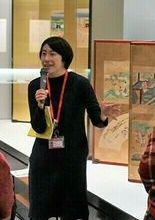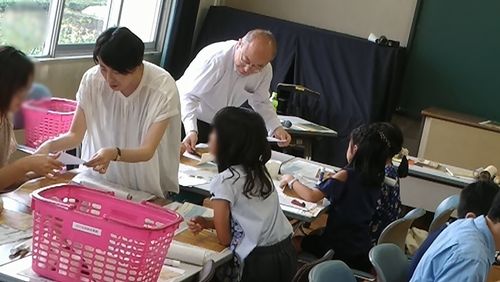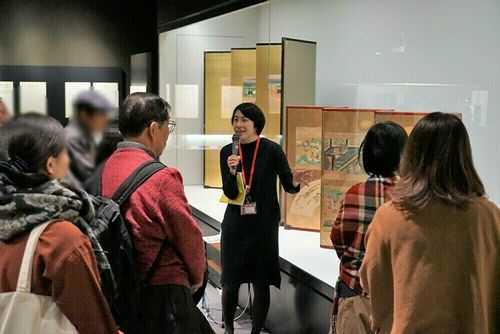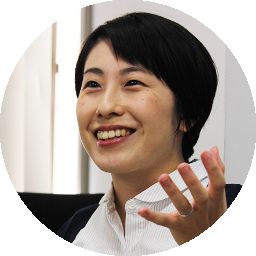Interview with Liberal Arts Communicator Shiori Kume

The National Institutes for the Humanities (NIHU) has been conducting research on human cultures from diverse angles to understand how individuals as well as nature and humans can harmoniously coexist with each other. To that end, we believe it is critical to facilitate communication between the researchers at the forefront of research and society.
As part of this effort to enhance such communication, NIHU holds various events for the general public and also provides training programs for liberal arts communicators who facilitate and engage in “two-way communication” between experts and non-experts. Who are these “liberal arts communicators?” What kinds of activities do they engage in? We will answer those questions in a series of articles.
The fifth article in this series is about Dr. Shiori Kume at the National Institute of Japanese Literature (NIJL). Dr. Kume took her position as a liberal arts communicator from September 2018. We asked Dr. Kume to look back on her projects as a liberal arts communicator and share with us projects she has in mind for the future.
In addition to being a liberal arts communicator, you are also a specialist in Japanese literature. What are you research interests?
I am studying various forms of narrative storytelling (katarimono) that were popular from the fifteenth through the seventeenth centuries. These include the kowaka dance, sekkyo, and kojoruri genres, which emerged as performing arts for verbal narration of long tales. As these art forms became popular, the stories began to be written down and were gradually compiled as scripts to be read. Such texts circulated both in hand-copied and woodblock-printed form and were also enjoyed as beautifully illustrated handscrolls and picture books.
I am interested in emergence and style of these genres as performing arts, but my attention is focused on the texts that were produced in the process of writing down the tales. Until a few years ago I was intrigued by the cultural history surrounding sekkyo and kojoruri , and other illustrated narrative tales and did a survey of holdings of such texts in various collections. In Japan these collections include those at the Umi-Mori Art Museum and Itsuo Art Museum and overseas at the Chester Beatty Library in Ireland and the National Library of France. The findings of my research was recently published (“Sekkyo-kojoruri o daizai to shita kaiga shiryo ni tsuite” [An Introduction to the Illustrated Book and Scrolls of Sekkyo and Kojoruri], Kokubungaku Kenkyu Shiryokan kenkyu kiyo: Bungaku kenkyū-hen [The Bulletin of The National Institute of Japanese Literature] 46, March 2020) and now I am looking into the so-called Hogan mono genre of kowaka dance or tales of the life of Minamoto no Yoshitsune.
Please tell us what inspired you to become a liberal arts communicator.
One reason that I sought out the liberal arts communicator position was because of my experiences teaching Japanese (Kokugo) at a night school for high school students. I served as a part-time teacher for four years there while writing my thesis as a doctoral student. Unlike the students at daytime high schools, those attending night school are mostly trying to earn their diplomas while working, so some of them were too tired to focus much on their studies. Determined to spark their interest, I would throw out questions I hoped they would really want to answer and make worksheets that I hoped they would want to fill in; I spent my days revising and revising the questions and handouts toward that goal. But in the course of that daily routine, my desire to present difficult content in ways that were enjoyable and easy to understand grew stronger, and I began looking for such a job. When I saw the job opening for the liberal arts communicator position, I remember the thrill I felt to find that there was a position that offered exactly what seemed to me the ideal work. Another factor that led me to this job was the environment at the high school where I taught: there were many veteran teachers who had been working with night-school students for several decades and they provided me with wonderful teaching resources; the mentoring I received there was really valuable.
Since becoming a liberal arts communicator, I have received practical advice from the faculty of the National Institute of Japanese Literature Planning and Public Relations Office where I am based and the other professors who deliver fascinating lectures to students. I understand how, instead of just thinking about things and practicing alone, one can achieve so much more fulfilling results by consulting with others about one’s ideas, pooling people’s wisdom, developing and improving on those ideas, and planning and managing in cooperation with others.
You are involved in planning exhibitions and workshops, managing interview requests, and various other activities. Can you tell us about an experience that has been memorable?
That would be the special exhibition held at NIJL from October 15 to December 14, 2019 entitled “Hon no katachi, hon no kokoro” (English title: Various Japanese Writings). It was my first experience being assigned to work on an exhibition, responsible for everything from the layout of the exhibits to the compilation of the exhibition catalog, and I learned a lot from this experience. I was invited to join the special exhibition team made up of professors Atsushi Iriguchi, Hiroshi Ochiai, and Kenichi Kansaku. In the course of developing the exhibition with them I observed the professors’ ideas about the ways documents should be displayed and the catalog edited and their determination to make the exhibits understandable to a lay audience. It proved an excellent introduction to the basics a liberal arts communicator needs to master. I joined the team not long after returning from maternity leave, so it was also a memorable experience as I struggled to readjust to working away from home.
Another project that made a deep impression was a workshop we held on illustrated handscroll-making at the request of the Nishisuna branch of the Tachikawa City Library. The workshop was planned by the Library to promote familiarity with books made with traditional Japanese bindings (washo). I introduced this subject to elementary school children by having them make handscrolls for the stories of Urashima Taro and Kootoko no soshi using paper, rolled-paper cores, and other household items. The process, which I had thought to be quite simple, turned out to be fairly difficult for the children and we ended up using much more time than originally planned. It was a significant lesson learned.
I feel nothing but gratitude to the participants who worked hard to complete the handscrolls despite the extended time required, but it was a day when I felt that, depending on how it was introduced, the world of traditionally bound books and handscrolls could be appreciated by people of all ages.

Workshop designed for elementary school students to make handscrolls.
Please share with us some moments when you felt rewarded for the activities you have engaged in.
It’s when people who didn’t know anything about washo became interested and curious about them through our workshop. Washo could be an opening, we might hope, through which people can find greater enrichment in their lives.
The handscroll-making workshop, for example, was based on my handscroll-making experience as a child. When I was in the fifth grade, our summer homework was to choose a famous historical figure, research him or her, and write up our findings on large sheets of paper. Instead of an individual person, I wanted to learn about the lives of farmers, so I looked up information about farmers’ lives through the four seasons, drew pictures of them doing various things, and wrote about them. Just drawing and writing what I had found out on big sheets of paper was unexciting, so I decided to lay out my project in the form of a handscroll and make it look as if it were from olden times. I really enjoyed making the handscroll. At the time I knew nothing about the structure and form of a handscroll, so I made it as I knew it using traditional-patterned fabric for the cover and attaching a tying cord, and submitted it as my project. That handscroll has since become a treasured keepsake.
The world of classical literature may seem very difficult and high-brow, but there is definitely room for people to learn about this field through their curiosity—as in my case, about the structure of the handscroll—or their delight in the beautiful patterns of the covers of traditional hand-bound books. By such paths, people may venture into the deeper aspects of the classics and become fascinated with them in unexpected ways. As a liberal arts communicator, I hope to play a role in planting the seeds of such curiosity and interest.
Is there any project you are working on now that you can tell us about?
Due to the COVID-19 pandemic, all the exhibitions and workshops that we had planned have been postponed. The gallery lectures (talks by NIJL scholars about works displayed at our gallery room) that were part of our regular operations have been cancelled for the time being and opportunities for a liberal arts communicator to be active have been greatly reduced, which is a source of great concern to me.
What I am doing now, however, is taking this opportunity to pursue the online publicity activities I have been working on from before the pandemic. I am still at the planning stages and nothing concrete has been decided, but I am thinking of (1) creating coloring books based on classical works; (2) creating how-to-make-washo videos based on the workshops I have held so far; (3) writing a column to familiarize junior and senior high school students with the classics, and (4) creating quizzes for learning how to read cursive-style writing (kuzushiji). In addition, NIJL’s Professor Iriguchi has suggested various promotional activities using videos, so I hope to work with my colleagues at the Planning and Public Relations Office to put those ideas into action.
NIJL is quite remote from central Tokyo and we have long bewailed that visitors to the Institute are usually limited to researchers, students specializing in Japanese literature, and members of the local community. It is my hope that using online content such as those I am considering, we can let people in all walks of life be aware of NIJL and create more momentum for people to visit the Institute for our special and regular exhibitions.
(Interview: Ayumi Koso)

Dr. Kume giving her gallery talk at NIJL’s exhibition room.

Shiori Kume
Liberal arts communicator, National Institutes for the Humanities (NIHU) Center for Information and Public Relations; Project assistant professor, National Institute of Japanese Literature
Shiori Kume specializes in research on late-medieval and early early-modern period Japanese narrative literature including kowaka dance, sekkyo, and kojoruri. She received her Ph.D. in 2016 from the Graduate University for Advanced Studies, School of Cultural and Social Studies, Department of Japanese Literature. Before taking up her current position in September 2018, she was a post-doctoral researcher at the National Institute for Japanese Literature and recipient of a JSPS post-doctoral research fellowship.
